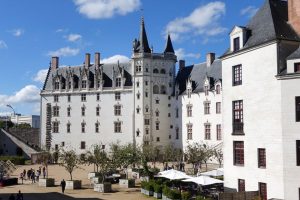The Castle Of The Dukes Of Brittany, A Nantes Wonder
The Castle of the Dukes of Brittany is a gem of the Urban History of the City of Nantes, nestled in the centre of the Medieval Quarter, the house of the Kings testifying to a multitude of historical details. Since 1862, it has been listed as a Historic Landmark for its accessibility to disabled persons. Let’s go back to its features and past that deserve a detour!
A Symbolic History Of Brittany’s Attachment To France
Originally the defensive centre of Nantes, designed by the Dukes of Brittany in the 13th century, the castle is a gem used both as a main ducal residence and as a stronghold holding a garrison resisted during the Insane War by the King of France. At the end of the 15th century, this fortress was ruined by François II, the last duke of independent Brittany, who erected the castle visible today in its place.
François II ‘s daughter, Anne of Brittany, was married twice to the French Crown embodied by Charles VIII and Louis XII. These marriages cause François 1er, thanks to the “Edict of Union of Nantes” of 1532, to definitively bind Brittany to France, not to be confused with the “Edict of Nantes” of 1598, bringing an end to the Wars of Religion.
From then on, during their Breton visits, the Castle welcomed all the Kings of France within its walls, a Royal Fortress. The French Revolution was opposed by the State Jail, Barracks and Military Arsenal, and was eventually partially defeated by the Powder Reserve Explosion in 1800.
In favour of a patrimonial concern, the military roles of the site were then eventually abandoned. The land was sold to the city of Nantes in 1915 following many restorations.
Architecture With Two Faces
The castle has preserved from its war age the exterior look of a fortified castle since the dawn of its construction, which started with the Tour Neuve, the foundations of which are still visible: a moat that enables a drawbridge to cross a thick surrounding wall with seven towers. The Loire had already passed at the foot of the Schist and Granite Walls before filling in.
The Panorama Switches Completely Inside. Mainly visible from the courtyard are the Tufa façades of the houses. Several accommodating buildings are indicated by the various transformations and ornaments produced through the centuries: The Castle of the Dukes of Brittany was particularly intended to accommodate the Dukes and Kings of France.
With their Renaissance-Inspired loggias, the most imposing structures are the residences. The first to be designed by François II and leaned against the curtain wall were the Grand Logis and the Grand Gouvernement. Overall, many of the residences of the Palace are clustered around the walls, indicating an influence from Château De Langeais or Châteaudun.
Each constituent element has unique characteristics, which offer a particular richness to the location. Dazzlingly white are the houses. The Grand Logis is adorned with plant motifs, with five skylights and curtains. The One In The Middle Is The Emblem Of The Alliance Between Brittany And France: We Can See Louis XII’s Porcupine Facing The Sculpted Greyhound Of Anne Of Brittany. The Horseshoe Tower derives its name from the shape of the Rocky Outcrop on which it is built. Curious tourists await more architectural surprises.
The Castle Of The Dukes Of Brittany Today: A Modern Museum

In 1924, the Castle was converted into a Regional Museum, with two independent museums dealing with the region’s common arts and Nantes’ maritime history. They displayed the same feature as the castle at the end of the previous century: dilapidated. A restructuring lasting more than 15 years between 1990 and 2007 gives it a fresh look, and you can explore the Nantes History Museum by going there today.
In the 32 spaces, you will appreciate new gems fitted with the newest digital technology, no fewer than 1150 works retracing the life and history of the city of Nantes since antiquity. There are four main topics offered:
The Commerce with Slaves And Slavery
• The World Wars Two
• Industrialisation
• The Dukes of Brittany Castle
You will also be able to discover, often at night, temporary exhibits! Note that, due to the idea of universal history, the museum is seeking to modernise its approach, highlighting the historical aspects with the activities and the vision of various areas of the world. This is to make for deeper understanding and a step back.
The Castle of the Dukes of Brittany Exudes A Beauty Boldly Symbolizing the Union of Brittany with Our Country, A Must-See In Nantes. Immersed in its reflection, on the arm of the King of France, one would almost hope to find Anne of Brittany! Finally , the three hours you spend visiting the museum would be well allocated: its historical wealth is incredible.
You should also read : “Chinon Castle at the heart of French History“


